-
Consultation :
 "Doctor, I look sad!" Or "I am told I look tired whereas I'm not!" says the patient who, matching the action to the word, pulls on her temples and practices a "digital facelift‘’.
"Doctor, I look sad!" Or "I am told I look tired whereas I'm not!" says the patient who, matching the action to the word, pulls on her temples and practices a "digital facelift‘’.
These sentences and this gesture announce clearly to the cosmetic practitioner that a facial settling is beginning to disrupt the face of his patient, even if her request is a wrinkle or furrow filling by volumizing injection.
-
This settling must be evaluated and compared to three other signs of aging (loss of volume, muscle twitching, and surfacial skin weakening). To follow a logical sequence, treatment must be done primarily on the most damaged area.
Injection of a product to increase the volume (e.g. hyaluronic acid) is frequently performed in aesthetic medicine, sometimes improperly, and claims to rejuvenate a face only by a volume increase, can lead to non-aesthetic results, with unconvincing lunar and standardized aspects, if not very ugly. So there is a time for filling, very different from the lifting time which was the time for surgical facelift before the arrival of thread.
The aesthetic doctor must check that the skin of the patient is apt to be treated by the thread technique for which there is no formal contraindication, since permanent thread is neutral and can be removed if necessary.
If the patient wishes to see some results to be convinced, the ideal is to show pictures of treated patients who have given their authorization, in order to analyze similarities of settling and result.
The use of simulation software to predict the result always shows miraculous outcome that exceed the limits of honest information. So, we do not advise it to practitioners trained by SOMEREFs.
The aesthetic practitioners also need to ensure that the patient has realistic expectations of treatment, that she understands the ins and outs, and that her motivation is strong enough to bear the common discomforts of the week following treatment.
Clear explanations are essential to this information and a file will be provided at the end of the consultation.
It must include an estimate and a medical questionnaire, which will enable consideration of possible personal pathologies with special attention.
With this file, the patient will take the time to think and will choose to undergo an intervention only if she is able to give her confidence to the practitioner. If it’s not the case, she must abstain or postpone its decision.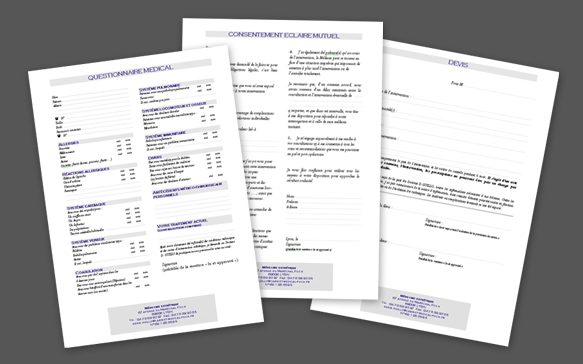
-
Implantation :
 The medical context (or surgical) in which thread is implanted is important, since it must give to patients best guarantees of security, without being as stringent as the use of a surgical unit, not justified in any way for implantation under local anaesthesia.
The medical context (or surgical) in which thread is implanted is important, since it must give to patients best guarantees of security, without being as stringent as the use of a surgical unit, not justified in any way for implantation under local anaesthesia.
-
A dedicated room, a perfect lighting, sterilization compliant to standards and disposable instruments for a good asepsis of the patient and medical staff is the rule for this level of practice.
The procedure is done under local anaesthetics, sometimes under sedation if the patient is anxious.
The SILHOUETTE SUTURE ® mixed thread are rather implanted under neuroleptanalgesia, so under the supervision of an anaesthesiologist, which increases both the risk and the cost of the operation. It is more true to say, they were presented to surgeons in a culture where general anaesthetic and facelift are related.
The Implantation is then precisely done, zone by zone, according to drawings made previously on a seated patient and the length can vary from ½ hour to 2 hours depending on the magnitude of settling and above all on the therapeutic project.
The phase of tension and symmetry adjustment must be rigorous and never hasty.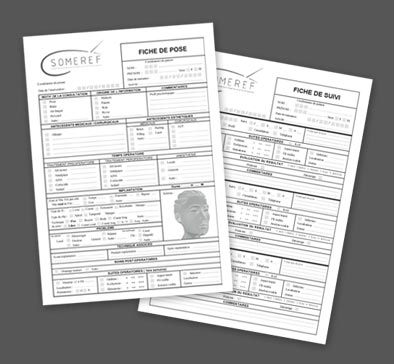
-
THE AFTERMATH OF THE INTERVENTION: The first week
Thread is implanted with needle’s blunt tip, non-aggressive, so non-traumatic for tissues. Nevertheless, some perfectly normal problems may happen after surgery.
Bruising is frequent as well as swelling in predisposed patients and those who would not have rested during the first day. Preventive treatment and the postoperative lymphatic drainage will make them disappear.
Pain, rather similar to tension is sometimes strong during the first days.
The use of analgesics and anti-inflammatory is possible, but some patients do not need it.
A pulled-up aspect of the face, worrying some sensitive patients, may be visible a few days, especially on thin skins.
In general, the patient can be seen after one week, even if it means wearing heavier makeup for a few days. photo ecchymose, aspect tracté
photo ecchymose, aspect tracté -
The very sharp needles of previous implantation have been replaced by blunt tip needles (which don’t cut), non-traumatic, which, when passed through the hypoderm, are among the less aggressive instruments to work under the skin. The scalpel, the surgeon's emblematic tool, is not used in this technique.
It is worth adding to the local anaesthetic (lidocaine) a product reducing the diameter of vessels (adrenaline) to further minimize risks of bruising. To anesthetize the only points of entry and exit of the thread rather than their whole course can cause longer recovery
A device to pass loops through, used from the temple to the cranial apex in order to join the threads in the EASYLIFT ® system , is not sharp and slips under the skin and scalp without harming them.
Bruises, variable in size, remain the most common symptom in the aftermath of an implantation, and are closely related patient’s predisposition. The location of implants is also decisive, because the whole periorbital area is likely to bleed more easily.
Oedemas, sometimes significant in the upper and lower eyelids area, are also the prerogative of predisposed patients.
They can be prevented notably by appropriated treatment (corticosteroid) and their resorption accelerated by manual lymphatic drainage.
Pains, rather perceived as great traction with new high threads are also felt very variably.
They can be painful for 3-7 days, improving when lying down, and fading completely in a few weeks in the vast majority of cases. They are usually well controlled with simple analgesics. They sometimes persist, often in one area, and a little local manoeuvre can eliminate them.
The requirement to change the thread because of a persistent pain has become absolutely exceptional.
The most recent threads produce much less pain than their predecessors, in the short or long term after implantation. The temporal area is where you can find the most sensitivity to touch, even in the long term.
The taught aspect is typical of this technique and can be visible for several days, rarely several weeks, if skin is very weak or distended. It often surprises patients, frightened to see it persist. It is in fact necessary for a few days with patients whose skin is thin, since a light distension, which must be anticipated will happen within days after surgery.
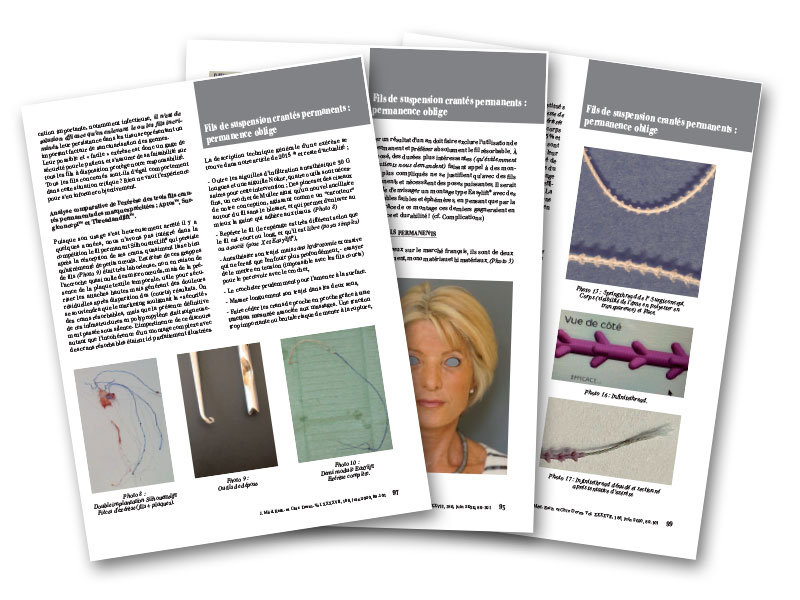 Fils de suspension crantés permanents : permanence oblige (PDF, 2020)
Fils de suspension crantés permanents : permanence oblige (PDF, 2020) 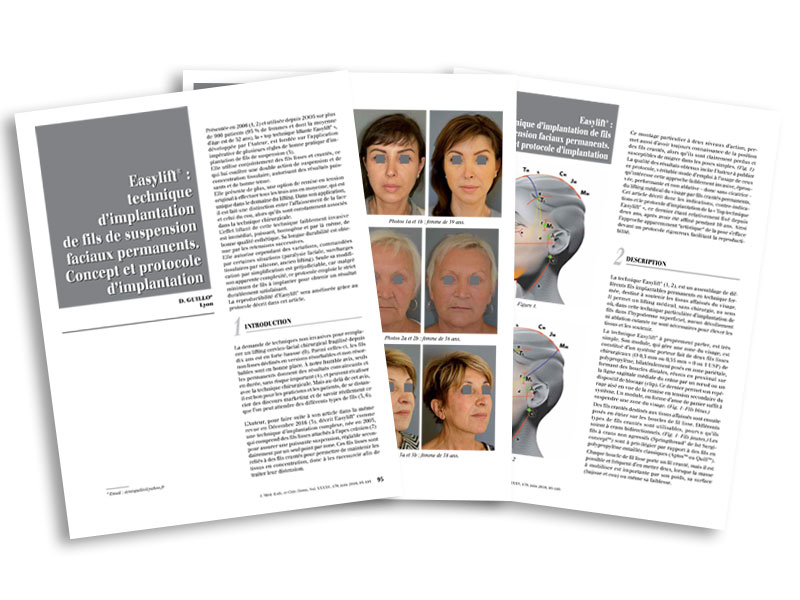 Easylift® : technique d’implantation de fils de suspension faciaux permanents.
Easylift® : technique d’implantation de fils de suspension faciaux permanents. 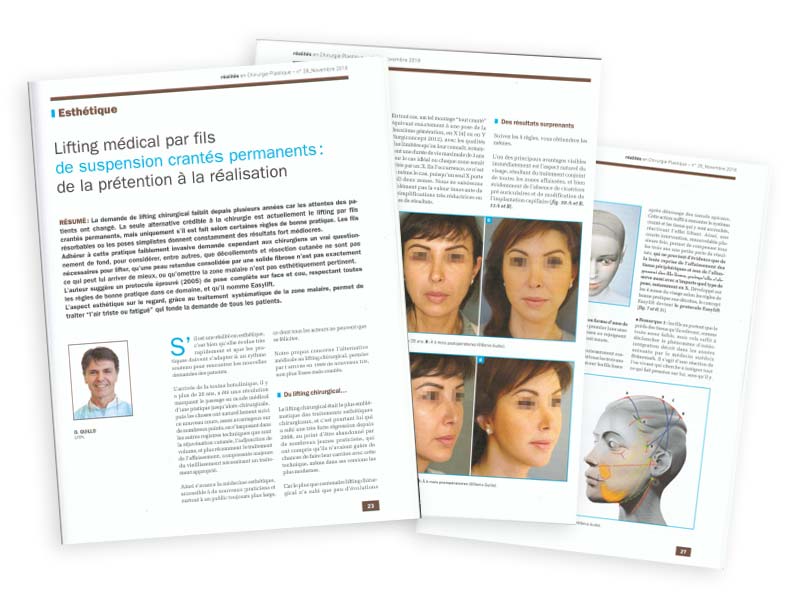 Lifting médical par fils de suspension crantés permanents
Lifting médical par fils de suspension crantés permanents 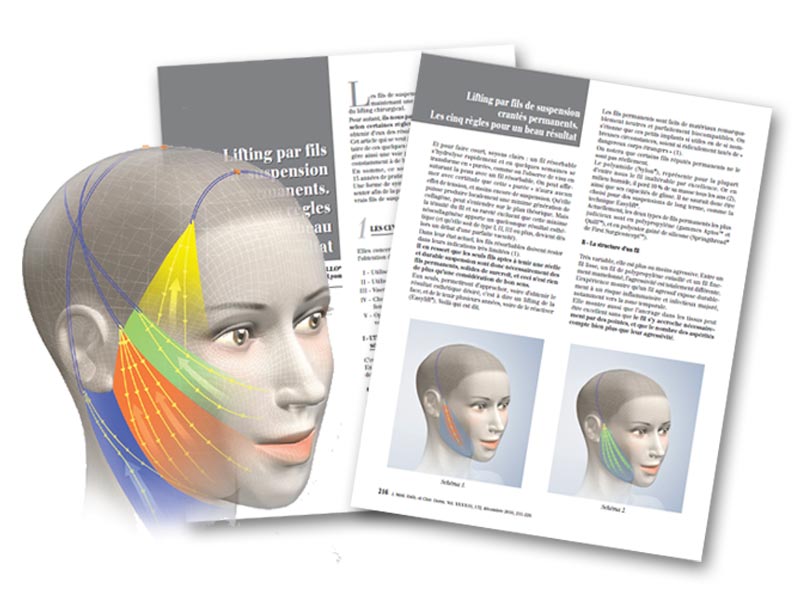 Lifting par fils de suspension crantés permanents
Lifting par fils de suspension crantés permanents 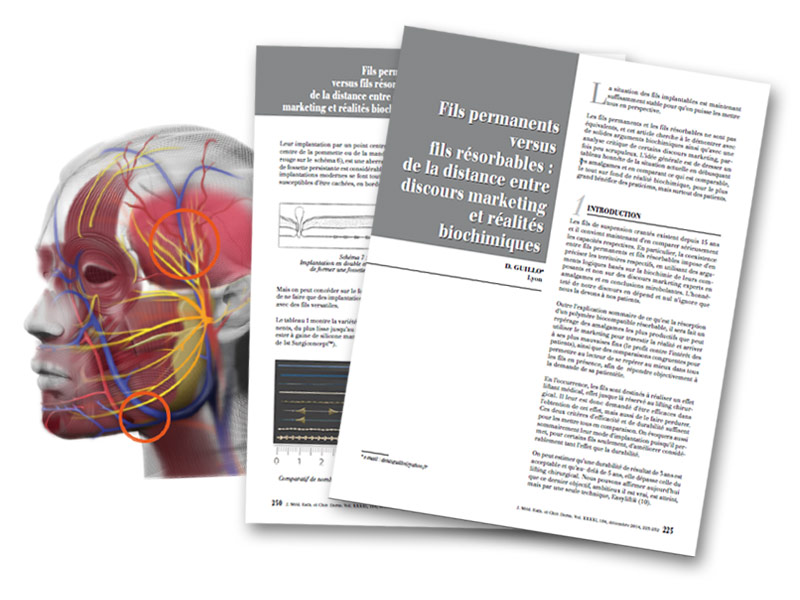 Fils permanents vs fils résorblables : de la distance entre discours marketing et réalités biochimiques
Fils permanents vs fils résorblables : de la distance entre discours marketing et réalités biochimiques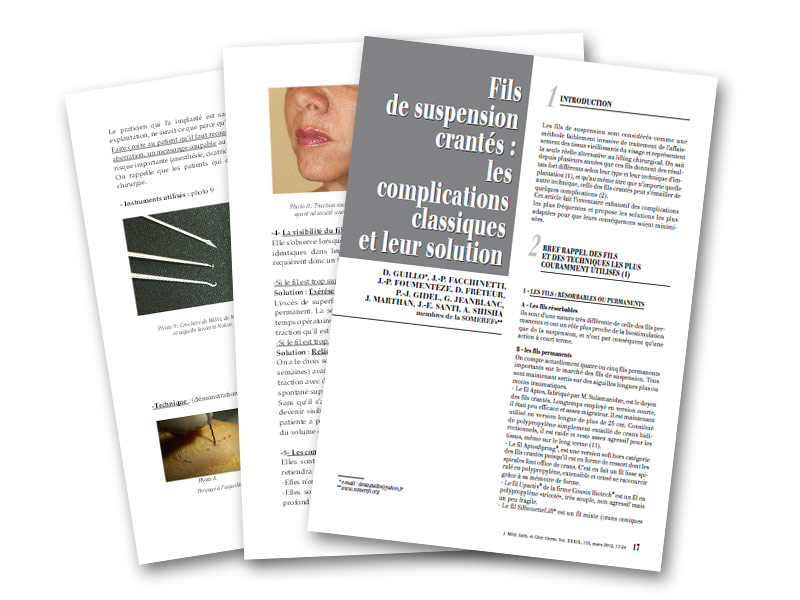 Fils de suspension crantés : Les complications classiques et leur solution.
Fils de suspension crantés : Les complications classiques et leur solution.